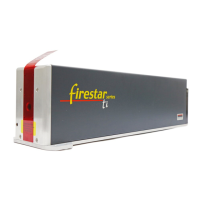getting started
19
Synrad Firestar ti-Series operator’s manual
Connecting
Chiller preparation guidelines
■You must provide fittings to adapt the laser’s 1/2-inch O.D. polyethylene cooling tubing to your
chiller’s Inlet and Outlet ports. These fittings can be “quick disconnect” or compression type fittings.
■Because Firestar’s cooling tubing is specified in inch sizes, the use of metric tubing fittings is discour-
aged unless you have installed the appropriate inch-to-metric tubing adaptors. Using metric fittings on
inch size tubing will lead to coolant leaks or may allow the pressurized tubing to blow-off the fitting.
Coolants
SYNRAD recommends that the laser’s cooling fluid contain at least 90% water (distilled or tap) by vol-
ume. In closed-loop systems, use a corrosion inhibitor/algaecide such as Optishield
®
Plus or equivalent.
Avoid glycol-based additives because they reduce the coolant’s heat capacity and high concentrations may
affect power stability. For SYNRAD lasers, the minimum coolant setpoint is 18 °C (64 °F) so glycol is not
necessary unless the chiller is subjected to freezing temperatures. In applications where biocides containing
chlorides are used, concentrations should not exceed 25 parts per million (PPM). Maintain a coolant pH
level above 7.0. We recommend the installation of a filter on the chiller’s return line, especially in areas
where water hardness is a problem. Firestar ti-Series lasers incorporate the following wetted materials in
the coolant path—aluminum, brass, copper, Delrin
®
, PBT, polyethylene, stainless steel, and Viton
®
.
Setting coolant temperature
Choosing the correct coolant temperature is important to the proper operation and longevity of your laser.
When coolant temperature is lower than the dew point (the temperature at which moisture condenses out
of the surrounding air), condensation forms inside the laser housing leading to failure of laser electronics as
well as damage to optical surfaces.
The greatest risk of condensation damage occurs when the laser is in a high heat/high humidity environ-
ment and the chiller’s coolant temperature is colder than the dew point of the surrounding air or when the
system is shut down, but coolant continues to flow through the laser for extended periods of time.
The chiller’s temperature setpoint must always be set above the dew point temperature. In cases where this
is not possible within the specified coolant temperature range of 18 °C to 22 °C (64 °F to 72 °F), then the
following steps MUST be taken to reduce the risk of condensation damage.
■ Stop coolant flow when the laser is shut down.
■ Increase coolant flow by an additional 1.0 GPM. Do not exceed a coolant pressure of 60 PSI.
■ Air-condition the room or the enclosure containing the laser.
■ Install a dehumidifier to reduce the humidity of the enclosure containing the laser.
■ Refer to Table 1-2 and gradually increase coolant temperature until it is above the dew point tempera-
ture and condensation disappears. Do not exceed a coolant temperature of 30 °C (86 °F).
Note: Water-cooled ti-Series lasers can be operated at coolant temperatures up to 30 °C to reduce prob-
lems associated with condensation; however, this may result in decreased laser performance and/
or reduced laser lifetime.
Table 1-2 provides dew point temperatures for a range of air temperature and relative humidity values.
Remember that the laser’s coolant temperature must be set above the dew point temperatures shown in the
chart; however, for best results and performance, use a coolant temperature in the range of 18–22 °C
(64–72 °F).

